Vanilla is in Crisis. Producers in Mexico Are Not Giving Up
Vanilla production is threatened by climate change in Oaxaca, Mexico. If vanilla disappears, local culture is in danger, too, say local Chinantec Indigenous people.
Vanilla is in Crisis. Producers in Mexico Are Not Giving Up
Vanilla production is threatened by climate change in Oaxaca, Mexico. If vanilla disappears, local culture is in danger, too, say local Chinantec Indigenous people.
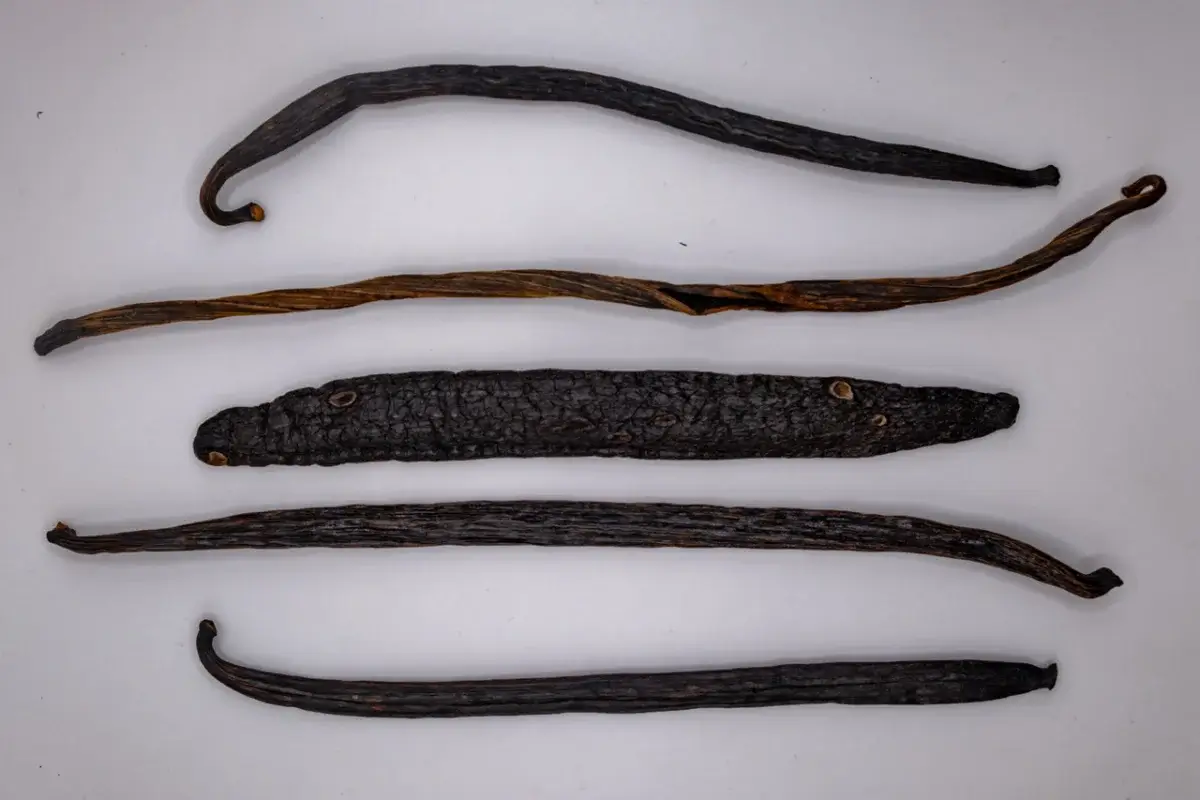
Local Indigenous Chinantes people found and named seven varieties of vanilla in the Chinantla region.Photography by Noel Rojo.
Huberto Juan Martinez (54) is not at home when we stop in front of his house in Cerro Armadillo Grande. “He is working on the plantation,” his wife announces. Huberto and his younger son are inspecting the plants that ensure the family’s livelihood. With their machetes in hand, they clear away any unwanted flora encroaching on their plot. As we stroll through the plantation, Huberto’s son nudges the oranges on a nearby tree, handing a few to us to enjoy along the way.
Coffee plants and vanilla thrive together beneath the canopy trees here. The agroforestry system that Juan Martinez has established on this small parcel of land draws inspiration from both—ancestral knowledge and the native environment where vanilla naturally grows.

While this way of growing vanilla is helpful in times of climate change, this year, local producers lost the majority of their production due to the extreme heat in the region.
Mexico belongs to the top five producers of vanilla. Between 2017 and 2021, the country produced 546 tons a year on average. Out of 7,704 tons produced globally in 2022, 518 tons were from Mexico, UN Food and Agriculture Organization reports. Most Mexican vanilla is produced in the state of Veracruz and only about 10percent comes from Oaxaca; such a loss, however, impacts local farmers in terms of their livelihood and cultural preservation.
Nature and culture
Vanilla is originally from Mexico. Vanilla in the Chinantla region in the southern Mexican state of Oaxaca, where Cerro Armadillo Grande is located, grows not only on plantations but also in the wilderness of local rainforests. La Chinantla region is known for a variety of microclimates, from tropical rainforests to cloud forests and mountainous terrains. Seven varieties of vanilla species can be found here, and it is possible that there are more that are completely wild and hard to trace in the jungle. “We named them all by the places where we found them,” says Elias Garcia Martinez (79), a Chinantec man who has spent the last 40years recovering Chinantec nature and culture. The most common is vanilla colibrí, named by a local hummingbird that pollinates vanilla in the wild.
READ MORE
Huitlacoche, a Mexican fungus, is popping up on restaurant menus across the US
Back then, in his village of San Felipe Usila, people were burning the forests to set up their plots to grow food. “We wanted to stop the fires and decided to introduce crops that would help us do so,” Garcia Martinez remembers. “We wanted to re-introduce native plants, such as cacao, pacaya palm that is edible, and vanilla. All these plants grow underneath the shade of trees.” While he was the one who brought up the idea, it turned out to be a project of the community. “We aimed to recover areas that suffered from environmental damage as well as re-evaluate our culture,” he says. To Garcia Martinez, vanilla is a strategy to preserve the jungle and the Chinantec culture. “If we stop naming certain species in Chinantec language because they are not present anymore, we start losing the language,” he explains.
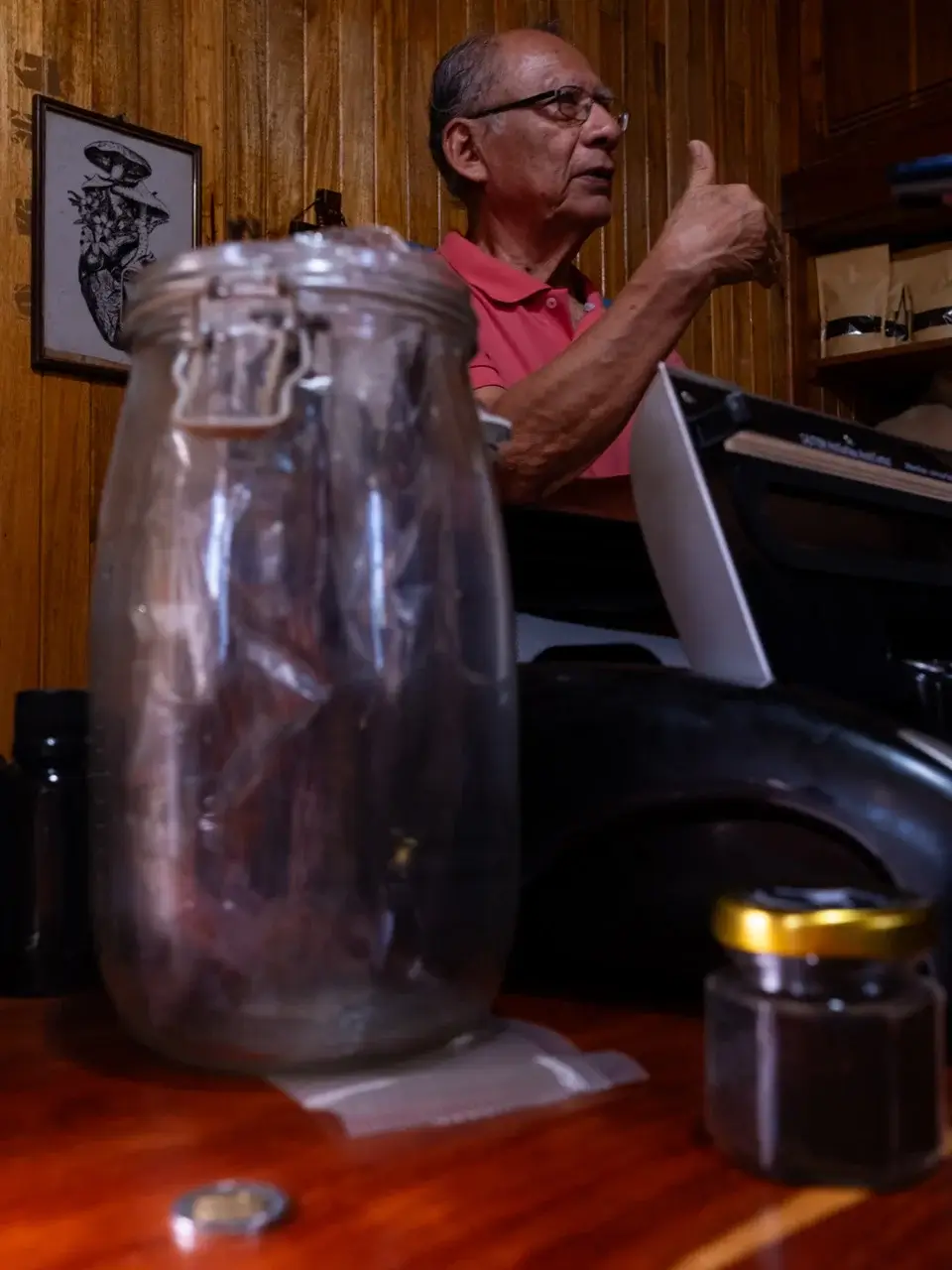
Ancestral practices
To preserve the culture, local farmers have put a lot of effort into implementing a variety of solutions to keep on producing vanilla. And, at the same time, these solutions are inspired by their culture, their communal way of organizing themselves as well as their cosmovision of being strongly connected to nature and to their place.
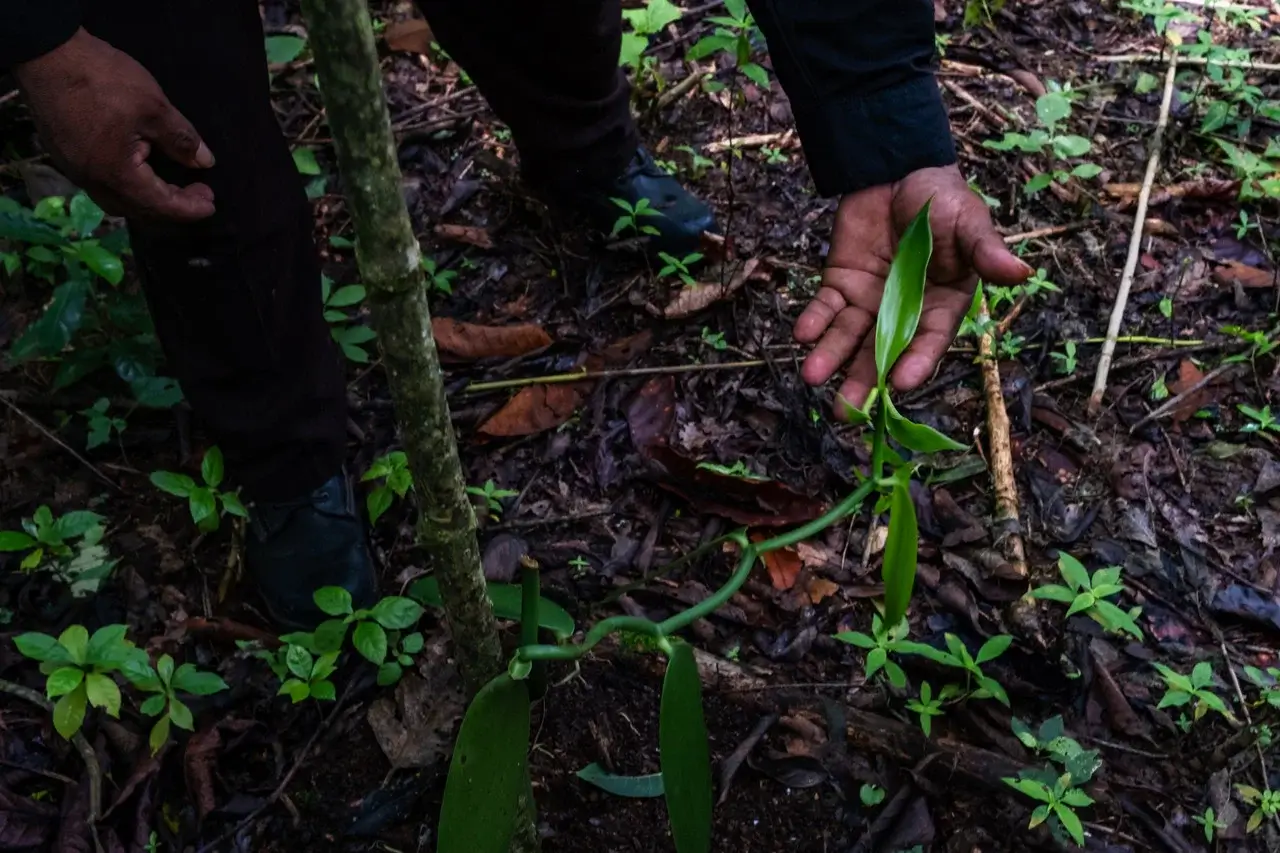
All vanilla grown in the region is protected by other trees. Just like Indigenous people in Oaxaca, and beyond, grow their main crops—corn, beans, and zucchini together on one plot called milpa—they often do the same with other plants, including vanilla. The plant is thus protected from the harsh sunlight while it absorbs nutrients from the surrounding vegetation. The agroforestry system also provides farmers with the chance to diversify their crops. Huberto markets coffee, vanilla, and even cedro trees for timber.
The oldest vanilla plants at Juan Martinez’ plantation are six years old. They are climbing up the supporting trees as if their leaves were hugging them. “There is a protocol of how to grow vanilla, what kind of trees serve as good supportive trees, and how to take care of the plant,” says Arturo Elias Garcia Gonzales (40). He is Elias’ son and our guide in La Chinantla. He buys vanilla from local farmers, dries it and sells it. Additionally, he manages his experimental plantation, Colibrí, in the nearby village of Cerro Armadillo Chico. He refers to it as experimental because it is a plot of land granted by the local community for him to test various methods and practices for growing vanilla.
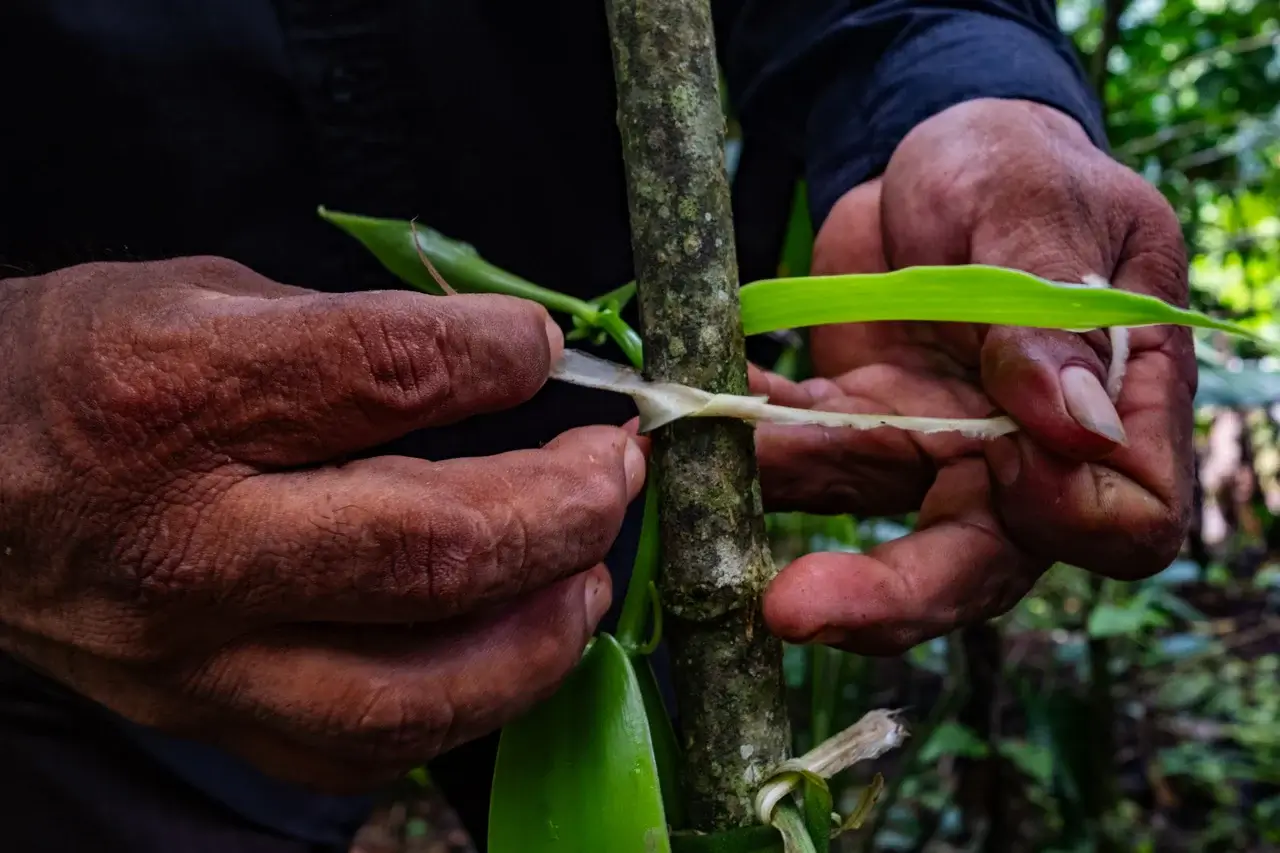
As we wander through Arturo’s plantation, it feels like we’re navigating a dense jungle. He deliberately planted only vanilla in this area. Among his 500 plants, a few have red bows tied around them. This, too, is an age-old tradition. “Here we believe in curses, or mal de ojo, we believe some people have a very strong look and without wanting, they could harm the plants. So, these red bows are to protect my plants from curses. And, at the same time, the plants that have red bows are the ones that are going to produce,” explains Garcia Gonzales.
He also mentions mutual help, which is another practice common in Chinantec communities, that he incorporates at his work. “It is a practice called mano vuelta or turned hand. Sometimes, people just do not have money to pay for work, so they ask somebody to give them a hand. For example, if I cannot come to the plantation, I ask Huberto if he can come and tend the plants,” Garcia Gonzales explains as Huberto is clearing the foliage around the vanilla plants on plantation Colibrí as we are visiting. “And then when he needs help and I am available, I support him.” Garcia Gonzales also uses this when promoting vanilla, for example, when restaurants invite him to talk about his experience with vanilla production.
Loss of produce
Yet, the way that the Chinantec people grow vanilla was not enough to protect the plants. Climate change is impacting vanilla production in many parts of the world, including in Madagascar—the biggest producer of this plant used worldwide as a fragrance and for the cuisine. “Vanilla production is at serious risk as a result of the effects caused by climate change,” says Alejandro Quirino Villarreal, professor at the Faculty of Agronomy at the University of Veracruz, for Diario Xalapa. He says scientists at his university are exploring adaptation mechanisms and how to make the plant more resistant to high temperatures in Veracruz, the place of origin of vanilla.
Vanilla needs to be grown in places where the temperature is between 25 and 35 degrees Celsius throughout the year. It also needs stable annual rainfall of approximately 1500 to 2500 millimetres to grow healthily.
LEARN MORE
Why we can’t get Mexico’s butter avocados in the US.
Juan Martinez already collected vanilla four times; however, this year, he lost most of his produce. “Vanilla pods fell due to extreme heat and droughts,” he says.
“All of our producers estimate that we lost about 80 percent of this year’s produce,” says Garcia Gonzales as he shows us the remnants of branches where flowers used to grow.
The drought season in Oaxaca aligns with the period of vanilla fruit growth. This year, rains arrived in June, but by mid-May, the plants had already started losing their fruit. To prevent the same thing happening again, La Chinantla producers are considering water capturing projects or irrigation systems, which are in demand across the state after this year’s dry season. “Due to our economic situation, we do not have an irrigation system here,” saysvanilla producer Francisco Mendoza from San Rafael Agua de Pescadito. Garcia Gonzales also admits that the lack of resources is one reason why water-capturing projects are lacking in the area. Nevertheless, the producers are actively investigating opportunities for potential partnerships and collaboration with local communities.
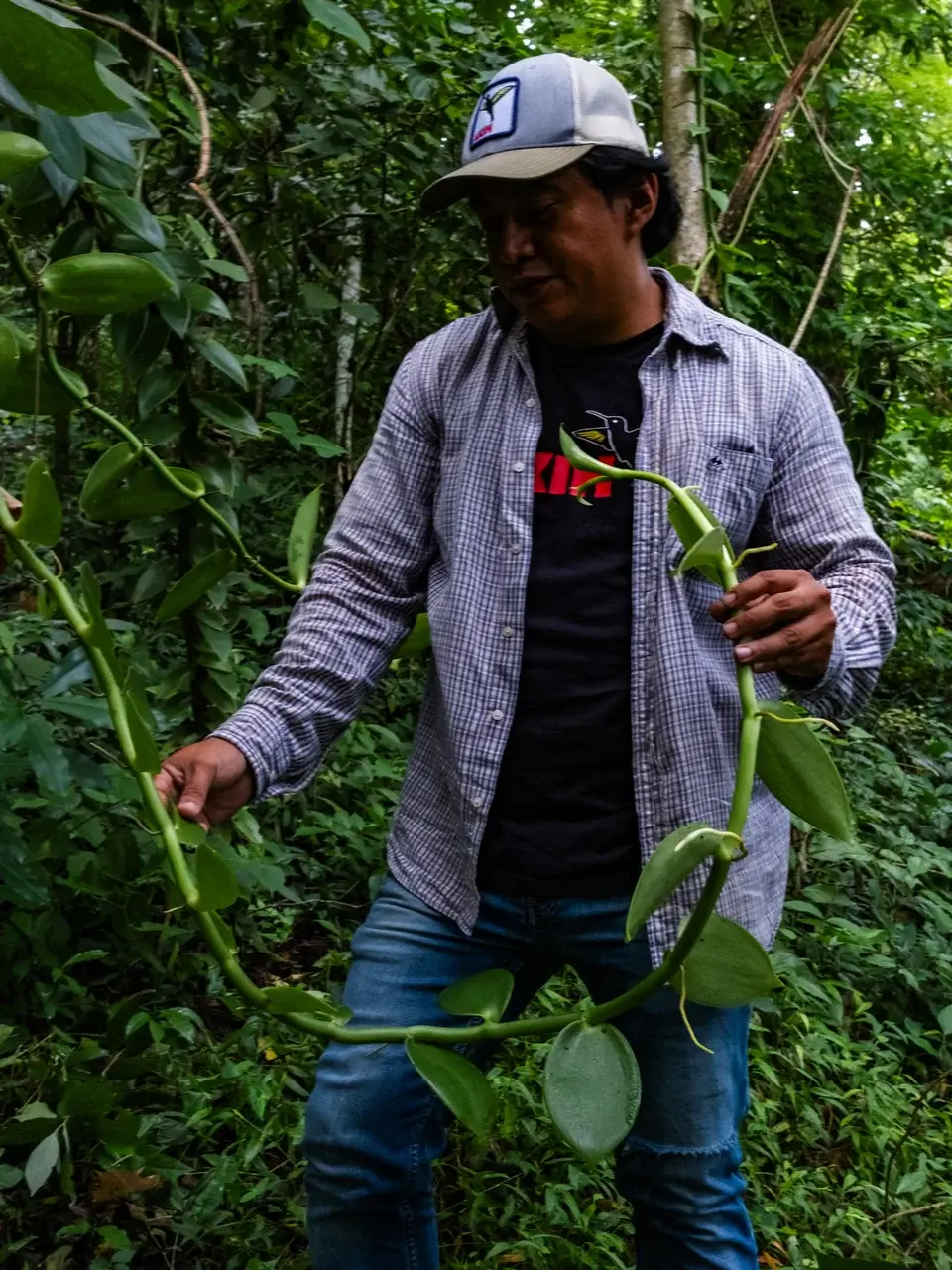
Vanilla is not the main crop Juan Martinez produces; it is more of a complementary one, yet such a loss still affects him, mostly because of all the investment that growing vanilla requires. “You need to come and check the plants frequently to make sure they are growing well. You pollinate them by hand when the orchid blossoms,” he explains.
Searching for market in Mexico
The scarcity of water is just one of the hurdles facing vanilla production in the La Chinantla region. Another significant issue is migration. Take Juan Martinez’s eldest son, for instance—he prefers to head north to find employment in Mexico rather than continue working as a farmer. And he is not the only one. When Slow Food—a global movement to ensure quality food that supports farmers across the world—became interested in vanilla production in La Chinantla in 2000, there were 150 families involved in the project. Slow Food helped bring visibility to Mexican vanilla production in the region. Nowadays, Akih vanilla, the project of Arturo Elias Garcia Gonzales, unites only 14 families. “Vanilla is a delicate plant. A lot of people are interested in producing it but with the first plague, they abandon the fields and search for another crop, or they migrate,” says Mendoza, who was a migrant in the US himself. He also calls for more technical support; for example, in regards to how to prepare organic fertilizer for his plants.
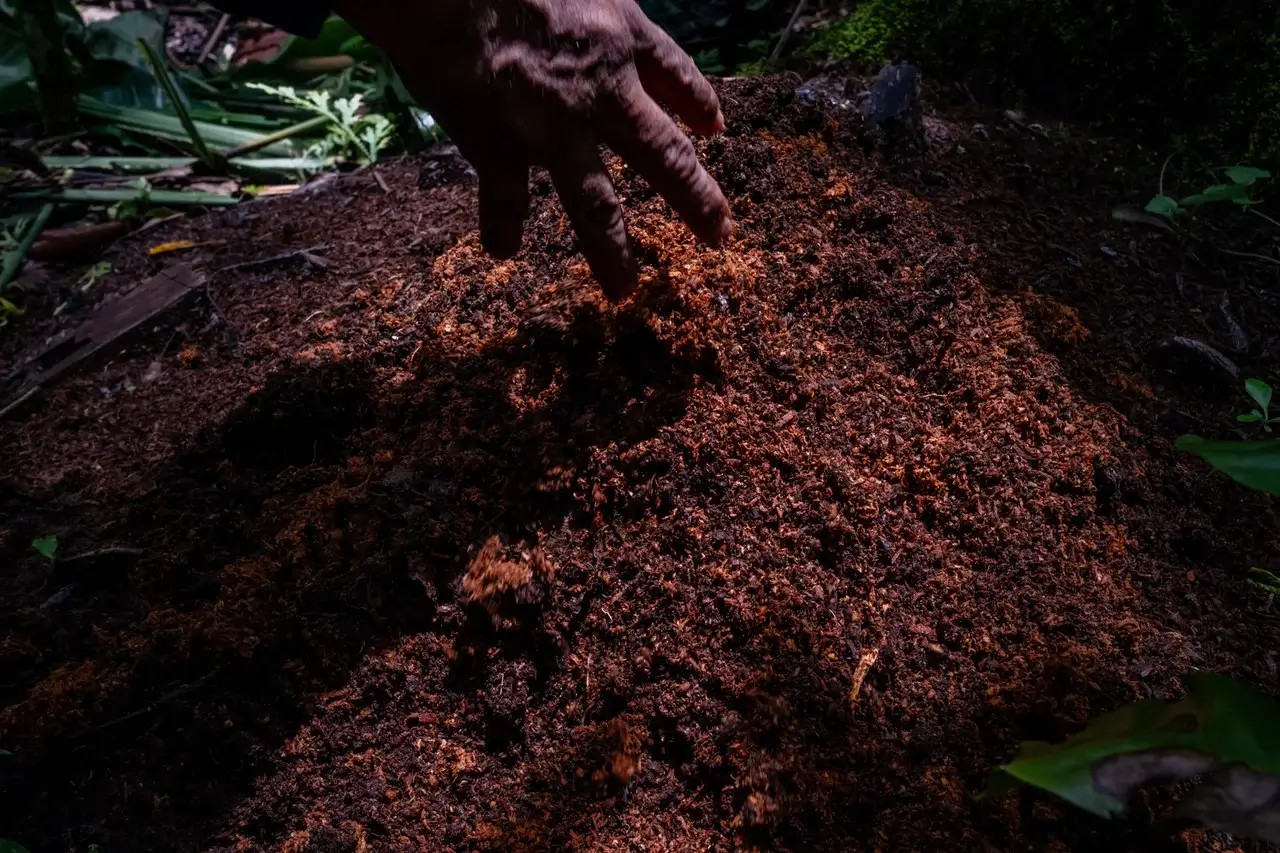
Garcia Gonzales and his father continually strive to draw more attention to vanilla, engaging producers as well as the wider public, including restaurants and buyers. “At the beginning, the majority of our vanilla was going to Europe. Nowadays though, we are promoting it within Mexico because the same people in Mexico do not know that vanilla grows in La Chinantla,” says Garcia Gonzales.
His intention is to set up another experimental plantation in San Felipe Usila. “The goal is to cultivate at least a thousand plants there, creating a kind of repository for the seven varieties,” he explains, detailing his vision for preserving vanilla and, by extension, safeguarding the heritage of his Chinantec culture.
Follow us
This work is licensed under a Creative Commons Attribution-NoDerivatives 4.0 International License.
Want to republish a Modern Farmer story?
We are happy for Modern Farmer stories to be shared, and encourage you to republish our articles for your audience. When doing so, we ask that you follow these guidelines:
Please credit us and our writers
For the author byline, please use “Author Name, Modern Farmer.” At the top of our stories, if on the web, please include this text and link: “This story was originally published by Modern Farmer.”
Please make sure to include a link back to either our home page or the article URL.
At the bottom of the story, please include the following text:
“Modern Farmer is a nonprofit initiative dedicated to raising awareness and catalyzing action at the intersection of food, agriculture, and society. Read more at <link>Modern Farmer</link>.”
Use our widget
We’d like to be able to track our stories, so we ask that if you republish our content, you do so using our widget (located on the left hand side of the article). The HTML code has a built-in tracker that tells us the data and domain where the story was published, as well as view counts.
Check the image requirements
It’s your responsibility to confirm you're licensed to republish images in our articles. Some images, such as those from commercial providers, don't allow their images to be republished without permission or payment. Copyright terms are generally listed in the image caption and attribution. You are welcome to omit our images or substitute with your own. Charts and interactive graphics follow the same rules.
Don’t change too much. Or, ask us first.
Articles must be republished in their entirety. It’s okay to change references to time (“today” to “yesterday”) or location (“Iowa City, IA” to “here”). But please keep everything else the same.
If you feel strongly that a more material edit needs to be made, get in touch with us at [email protected]. We’re happy to discuss it with the original author, but we must have prior approval for changes before publication.
Special cases
Extracts. You may run the first few lines or paragraphs of the article and then say: “Read the full article at Modern Farmer” with a link back to the original article.
Quotes. You may quote authors provided you include a link back to the article URL.
Translations. These require writer approval. To inquire about translation of a Modern Farmer article, contact us at [email protected]
Signed consent / copyright release forms. These are not required, provided you are following these guidelines.
Print. Articles can be republished in print under these same rules, with the exception that you do not need to include the links.
Tag us
When sharing the story on social media, please tag us using the following: - Twitter (@ModFarm) - Facebook (@ModernFarmerMedia) - Instagram (@modfarm)
Use our content respectfully
Modern Farmer is a nonprofit and as such we share our content for free and in good faith in order to reach new audiences. Respectfully,
No selling ads against our stories. It’s okay to put our stories on pages with ads.
Don’t republish our material wholesale, or automatically; you need to select stories to be republished individually.
You have no rights to sell, license, syndicate, or otherwise represent yourself as the authorized owner of our material to any third parties. This means that you cannot actively publish or submit our work for syndication to third party platforms or apps like Apple News or Google News. We understand that publishers cannot fully control when certain third parties automatically summarize or crawl content from publishers’ own sites.
Keep in touch
We want to hear from you if you love Modern Farmer content, have a collaboration idea, or anything else to share. As a nonprofit outlet, we work in service of our community and are always open to comments, feedback, and ideas. Contact us at [email protected].by Magdalena Rojo, Modern Farmer
November 6, 2024
Modern Farmer Weekly
Solutions Hub
Innovations, ideas and inspiration. Actionable solutions for a resilient food system.
ExploreExplore other topics
Share With Us
We want to hear from Modern Farmer readers who have thoughtful commentary, actionable solutions, or helpful ideas to share.
SubmitNecessary cookies are absolutely essential for the website to function properly. This category only includes cookies that ensures basic functionalities and security features of the website. These cookies do not store any personal information.
Any cookies that may not be particularly necessary for the website to function and are used specifically to collect user personal data via analytics, ads, other embedded contents are termed as non-necessary cookies.
I live in Costa Rica, and we grow vanilla as a hobby. But suddenly it is more than that, and we have a lot of it. It is a very interesting crop; very different in many ways. It is susceptible to disease and fungus. It is tough to find factual information on growing vanilla, in part because so much of the knowledge is held by native farmers who don’t record observations and don’t want to pass along information to potential competitors.I would love to find more information on how to grow it.
Thank you for telling the truth about the effects of climate change to people who sometimes would rather not be told hurtful truths.
Very interesting article! I had no idea how Vanilla is grown and how much it depends on good stewardship and climate. I hope those families can sustain their practices. Thank you for sharing this